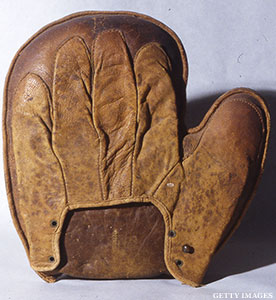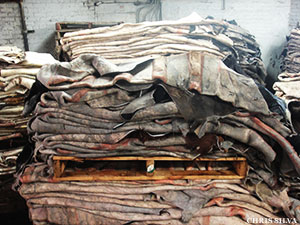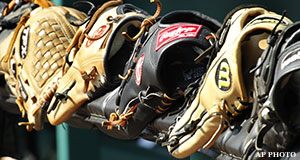When Philadelphia Phillies pitcher Roy Halladay delivered the first pitch of the 2011 All-Star Game, he did so with his usual black Nike Diamond Elite glove on his left hand. On the field with him, the rest of the National League starters represented a handful of the game’s longstanding glove manufacturers: Rawlings, Mizuno, Wilson, Easton and Nike.

A snippet of air time on national television that shows a player flashing some leather would make any glove company proud. Scour the internet message boards and you’ll find posts from fans wanting to know their favorite player’s glove model. In 2010, there were 5.1 million baseball and softball gloves sold in the U.S. that brought in approximately $208.7 million, according to the National Sporting Goods Association’s most recent Sporting Goods Market report. So the baseball glove industry is steady and still growing.
Who would have thought that a glove would evolve from two pieces of leather designed to prevent injury into a multimillion dollar business? And to think, there was a point in time when players were frowned upon for wearing a glove, the very instrument that has become as much a necessity as, say, a baseball bat to America’s pastime, a tool of the trade whose evolution through the 21st century can essentially be brought back to three cornerstone gloves: the Bill Doak glove, the Rawlings XPG and the Wilson A2000.
The history of the baseball glove can be traced back to as early as 1860, when players started to experiment with a glove as a form of protection, often of the brakeman type of glove used by railroad workers.
Cincinnati Red Stockings catcher Doug Allison was one of the first players to wear a buckskin mitten in 1870 after suffering a hand injury, and St. Louis' Charles Waitt was the first confirmed player to don a glove in 1875, although according to MLB official historian John Thorn, Waitt wore a flesh-colored glove in hopes of it going unnoticed.
"He wanted it to be surreptitious use because it was thought unmanly to not catch with bare hands," Thorn says. "Cricket players did not use gloves, so baseball players ought not to. That was the thinking in the 1870s."
But as hand injuries continued to occur, that psyche changed, and by the 1890s baseball gloves were the norm. Several glove experts, including Pittsburg-based Denny Esken, believes no one was credited for inventing the first baseball glove.
"There's plenty dispute, however, over who invented the catcher's glove, because the catcher took the greatest beating," Esken says. "For a catcher to appear in 100 games in a season was considered an incredible marvel of endurance because it was so difficult."
 There’s a claim for Harry Decker as the inventor of the catcher’s mitt. There’s also a claim made for Joe Gunson, which was largely made by Gunson, but there’s not valid evidence.”
There’s a claim for Harry Decker as the inventor of the catcher’s mitt. There’s also a claim made for Joe Gunson, which was largely made by Gunson, but there’s not valid evidence.”
Decker actually had a patent for the "Decker Safety Catcher's Mitt" in 1890. Gunson, meanwhile, was a catcher for Albert Spalding, who later went on to sell fingerless gloves with padded palms through his Spalding catalog.
One of the earliest baseball glove manufacturers was New Hampshire-based Draper & Maynard, which made its first padded glove for a Providence shortstop named Arthur Irwin in 1883. According to its website, D&M supplied gloves to nearly 90 percent of ball players in the 1920s, including Honus Wagner and Babe Ruth, then with the Boston Red Sox.
"Probably up until they were bought out, they were kind of the Rawlings of that day," says glove collector Joe Phillips, owner of Dallas-based The Glove Collector. "They were the most well thought of baseball glove."
Rawlings came to the forefront of glove manufacturing in 1919, when St. Louis pitcher Bill Doak went to the company with the idea of putting a web between the thumb and index finger. Known as the Bill Doak glove, it transformed the way a baseball glove was viewed: no longer as a means of protection, but as a tool.
"If you look at Web Gems, almost every play is made with the web of the glove, because it provides an extension and your fingers, in effect, get longer and you have a catching device," Thorn says. "You no longer have to catch it in the palm. When I was a boy and I was instructed on how to play baseball, you were always instructed to catch the ball in the palm of the glove and no one today would tell you that. It would be very difficult to catch the ball in the pocket of the glove while on the run. So the web is the key. So Bill Doak and his innovation is a landmark."
When players headed overseas for World War II in 1942, the gloves followed. Nokona Leather Goods, which began manufacturing baseball gloves eight years earlier, produced them exclusively for the servicemen stationed in the South Pacific, shipping some 250,000 gloves there each year so they could be used for recreational use.

Meanwhile, more glove innovation was already underway, and the 50s saw an influx of gloves hit the market: Wilson's A2000, which had a large web, broad pocket and would eventually become the official glove of MLB, came out in 1957; Rawlings' XPG, with its deep pocket and u-shaped heel, was released in 1958; and its six-fingered Trap-Eze debuted the following year.
"We start out trying to make the perfect glove for the major leaguer and if we succeeded then it became the perfect glove for retail," says Rawlings Senior Glove Designer Bob Clevenhagen.
Clevenhagen succeeded the father-son glove designer duo of Harry and Rollie Latina at Rawlings, both of who are responsible for some of the most iconic gloves and trademarks today: the Fastback, Heart of the Hide and the Trapper, to name a few.
While cheap labor led many glove manufacturers to export production to Japan and Asia in the 1960s, Nokona remained put, choosing to keep its entire operation at its Nocona, Texas-based factory.
"That's really what defined Nokona over the past couple of decades in that it was the only company that didn’t follow suit and go overseas and the reason for that is Bobby Storey, who is still the ambassador of the Nokona brand," says Nokona president Jeff Beraznik, whose Phoenix-based Cutters Gloves company became majority owner of Nokona a year ago. "He made the decision that he just did not want to take the production of ball gloves overseas. His comment was he would rather pack up shop and go fishing than follow everyone else and go overseas.”
Today, Nokona prides itself as the last U.S. maker of baseball gloves and one that caters to the high-end client. It competes with the Rawlings and Wilsons of the glove world and also against some of the more new-age glove makers, those who have gone outside of traditional leather to make more synthetic-based gloves for both the amateur and professional levels. Companies such as Mizuno, which has been around since 1913 but has been among the pioneers of both softer gloves and 3-D and 4-D technology used to better craft position-specific gloves.
New Jersey-based Akadema, too, has become a player in the glove game, with Hall of Fame players Ozzie Smith and Gary Carter lending their insight from the company’s inception in 1997. Akadema is producing more than 100,000 gloves a year, which contributes to the projected 2 percent increase in the sporting goods market for 2011.

While technology continues to shape the current and future state of baseball gloves, some things, it seems, have not changed throughout the years.
Take, for instance, the Chicago-based Horween Leather Company. In business since 1905, and in its current Bucktown location since 1920, Horween has been the official leather supplier for Rawlings since 1932. In an ever-changing glove industry, the leather tanning process has remained the same.
In the late 60s, early 70s, according to Horween President of Global Solutions John Culliton, production for Rawlings’ pro line took off for Horween when NBC had the Game of the Week with announcers Joe Garagiola and Tony Kubek.
"They used to have a microphone on the field and you could hear (the glove) pop, and that was a key for NBC because they wanted that," Culliton says. "So they said it had to be played with the Heart of the Hide Rawlings catchers glove, which is our leather, and it kind of took off."
The leather tanning process begins on the ground floor of the 180,000 square foot building, where hundreds of hides are stacked in neat piles, hair and all, waiting to get skinned by a man wielding a very sharp butcher’s knife. The hides come from across the Midwest and Canada, from major meat packers such as Tyson and IVP. There are 650,000 skins that get killed every week. Horween gets 1 percent of that. In turn, the top 3 percent of its production goes into baseball gloves.

Once the hides are skinned, they're put in one of four cement mixers where the hair is burned off over a 24-hour process. Once the hair is removed, the hides go into wooden drums for tanning, which is a base chrome tannage that’s been used since the 30s. It's a three-step process: baiting, pickling and tanning. After it's tanned, the leather is a soft blue skin.
It's one man's job to determine, based on weight, quality and skin, which of four piles a skin ends up: boots, belts, gloves or footballs. For baseball gloves, it cannot have any imperfections and it must be 5 1/2 ounces thick.
"They used to say that this spot right here will make or break your tannery,” Culliton said, "because if they miss a selection you’re going to have product that ends up in the wrong spot. So it’s a super important place because it allows you to merchandise your product line and if you merchandise it properly you have a really good product."
If it's done well, as has been the case for the last several decades, you end up with leather Rawlings marketed as Heart of the Hide, which they’ve used in gloves dating back to Mickey Mantle’s playing days.
But maintaining its integrity of using the best quality of hides for ball glove leather hasn't come without its obstacles. Because cattle is taken to the market at a much younger age these days, oftentimes at 14 months old, the skin is being stretched, which makes for sloppy fibers in the hides, which means the quality and durability of the leather is not what it once was. Over the years, tanneries have also had to adhere to regulations changes in the dyes and oils used to treat the leather.

And while much of that remains out of a tannery’s control, new glove makers such as Carpenter Trade Company have seized control of what it can. For Carpenter, that has meant leaving leather out of the equation all together. And it’s why owner Scott Carpenter feels that the future of baseball gloves has already arrived.
Email Chris Silva at christopherbsilva@gmail.com.





